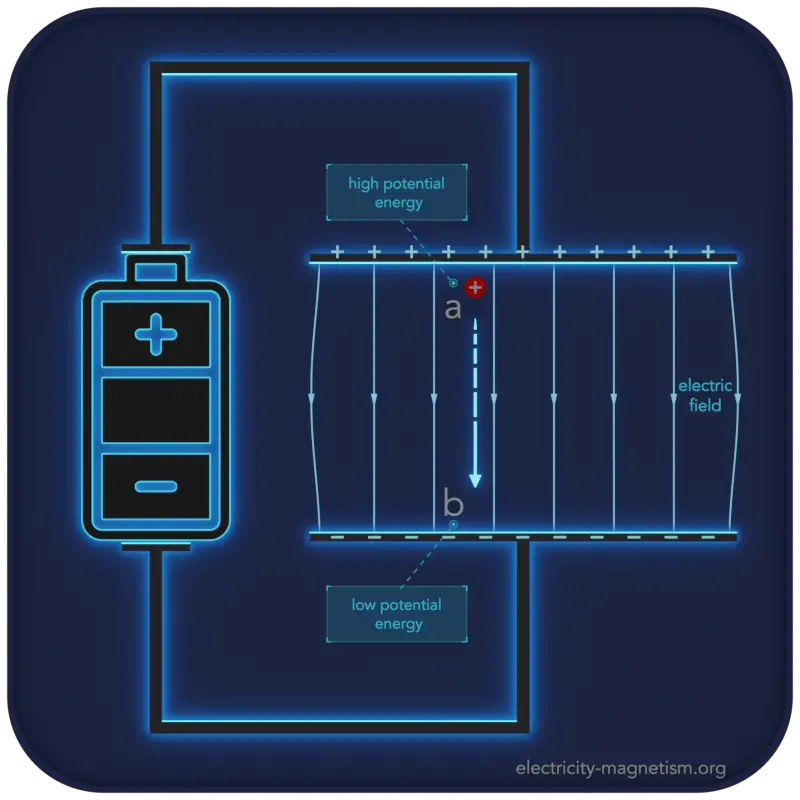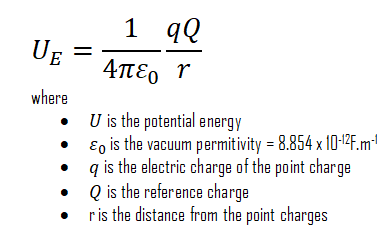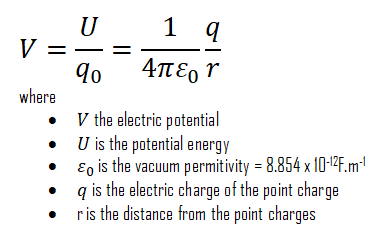30-second summary
Electric Potential Energy
Electric potential, denoted by V (or occasionally φ), is a scalar physical quantity that describes the potential energy of a unit electric charge in an electrostatic field.
Va = Ua/q
It is defined as the amount of work energy needed to move a unit of electric charge from a reference point to a specific point in an electric field.
Electric potential energy , denoted by U, is a scalar physical quantity that is needed to replace a charge against an electric field. The SI unit of electric potential energy is joule (J).

About Electric Potential Energy
Electric potential energy , denoted by U, is a scalar physical quantity that is needed to replace a charge against an electric field. The SI unit of electric potential energy is joule (J). For example, uhe electrostatic potential energy, UE, of one point charge q at position r in the presence of a point charge Q, taking an infinite separation between the charges as the reference position, is:

Alternatively, the electric potential energy of any given charge or system of charges is termed as the total work done by an external agent in bringing the charge or the system of charges from infinity to the present configuration without undergoing any acceleration.
Electric Potential
Electric potential, denoted by V (or occasionally φ), is a scalar physical quantity that describes the potential energy of a unit electric charge in an electrostatic field. It is defined as the amount of work energy needed to move a unit of electric charge from a reference point to a specific point in an electric field. If a positive test charge q in an electric field has electric potential energy Ua at some point a (relative to some zero potential energy), electric potential Va at this point is:
Va = Ua/q
In the International System of Units (SI), electric potential is expressed in units of joules per coulomb (J⋅C−1) , or volts (V). Although the concept of electric potential is useful in understanding electrical phenomena, only differences in potential energy are measurable. These differences in potential energy are measured with a voltmeter.
Note that an electric potential difference is analogous to a gravitational potential difference. In the latter case, a force is exerted on objects with mass. Charges experience a force when there is an electric potential difference. The direction of the force depends on the sign of the charge. The electric field E is analogous to g, which we called the acceleration due to gravity but which is really the gravitational field. Everything we learned about gravity, and how masses respond to gravitational forces, can help us understand how electric charges respond to electric forces.
The electric potential arising from a point charge Q, at a distance r from the charge is observed to be:

Frequently asked questions
Electric potential, denoted by V (or occasionally φ), is a scalar physical quantity that describes the potential energy of a unit electric charge in an electrostatic field. Va = Ua/q
ote that an electric potential difference is analogous to a gravitational potential difference. The electric field E is analogous to g, which we called the acceleration due to gravity but which is really the gravitational field.
Although the concept of electric potential is useful in understanding electrical phenomena, only differences in potential energy are measurable. These differences in potential energy are measured with a voltmeter.

